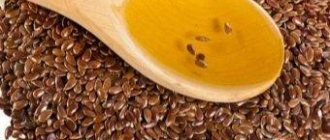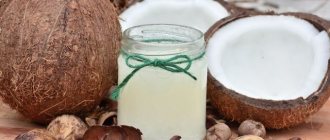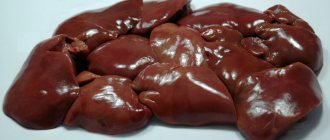Adequate nutrition for a mother while breastfeeding is the key to the proper development of the baby. The mother's body needs not only vitamins and microelements, but also fatty acids, which are not synthesized but come from food. These substances include omega-3 acids - DHA and EPA, the source of which, in particular, is flaxseed oil.
Nutritionists disagree about the safety of using this product during pregnancy and lactation. Let's consider the beneficial properties of flax oil and factors that can negatively affect the health of the mother and baby.
Flaxseed oil: benefits and effectiveness
The products that make up the diet of a nursing mother also affect breast milk, entering it over a certain period of time (from 30 minutes to a day, depending on what is eaten).
Flaxseed oil is no exception; its components penetrate into the blood and, as a result, into mother’s milk, and from there into the child’s body. It would seem, what danger could there be when the benefits of this product in general and omega-3 in particular have long been proven:
- prevention of vascular and heart diseases;
- normalization of pressure;
- formation of interneuron connections and, as a result, better brain function;
- improving the functioning of the gastrointestinal tract and increasing metabolism;
- normalization of the nervous system;
- improving the condition of skin, hair, nails.
Indeed, with long-term (more than 2 months) use of flaxseed oil, a noticeable beneficial effect occurs, but its use by a nursing mother is associated with a certain risk, the reason for which lies in the plant estrogens contained in the oil.
Benefit
Natural butter without synthetic additives is a valuable product for nursing women. Its benefits are determined by the properties of its constituent substances:
When feeding, the listed groups of substances affect both the body of the mother and the child. All of them pass into breast milk to one degree or another.
Many mothers believe that it is better for them to completely replace butter with vegetable oil, but this is a mistake. Milk fat is digested faster than vegetable fat, and absorption occurs at 98.5%. The fatty acids included in its composition are extremely important for the functioning and regeneration of cells.
The delicacy contains saturated and unsaturated acids in approximately equal proportions. Some of them are essential, that is, those that are not produced in the human body, but take part in metabolic processes. Functions of unsaturated fatty acids (oleic, arachidonic, lauric, linolenic and others):
- synthesis of hormones, including thyroid (thyroid) and sex hormones;
- regulation of blood cholesterol levels;
- renewal of nerve fibers;
- synthesis of bile acids;
- blocking the growth of atypical cells;
- participation in the formation of intestinal microflora;
- increasing the body's resistance.
The product is easily digestible and provides the body with energy. Its use gives strength, which mothers often lack during breastfeeding.
The oil contains vitamins A, E, D, K. They are also present in other products, but are fully dissolved and absorbed only in the lipid environment. Therefore, milk fat can be called their optimal source. These vitamins are necessary for:
- ensuring the normal condition of the skin, hair and nails;
- health of bone tissue and teeth due to the absorption of calcium and phosphorus;
- strengthening the immune system;
- ensuring the integrity and regeneration of mucous membranes;
- maintaining visual acuity.
80% of high-density lipoproteins are synthesized in the human body, 20% comes from food. Their functions:
- destruction of sclerotic plaques on the walls of blood vessels;
- capture and transport of low-density lipoproteins to the liver, where they are processed;
- participation in lipid metabolism;
- synthesis of hormones;
- vitamin D production;
- support of serotonin reactions that affect the emotional state;
- ensuring stable operation of cells and their membranes;
- improving the functioning of the immune and nervous systems.
Nutritional value
Few medicinal plants can boast the same nutritional properties as flax. This product is classified as a nutraceutical. This is the name given to natural energy substances that have a general strengthening and rejuvenating effect on the body.

Flax has a high content of the following substances:
- easily digestible protein;
- fiber;
- vitamins;
- phytoestrogens;
- a number of minerals;
- more than 22 amino acids;
- lignans with antitumor effects;
- fatty acids necessary for the full development of the baby.
Flax is quite high in calories: the calorie content of 100 grams of seeds is 550, and 100 milliliters of oil is 880. This is explained by the high proportion of polyunsaturated fatty acids in the product.
Composition and beneficial properties of the product
Flaxseed flour, oil and seeds are eaten. Useful decoctions and infusions are prepared from this medicinal plant. The product retains its medicinal properties in any form.

Table: chemical composition and calorie content of flaxseed
| Nutrient | Quantity | % of the norm in 100 g* |
| Calorie content | 534 kcal | 31.7% |
| Squirrels | 18.29 g | 24.1% |
| Fats | 42.16 g | 70.3% |
| Carbohydrates | 28.88 g | 13.7% |
| Alimentary fiber | 27.3 g | 136.5% |
| Vitamins | ||
| Vitamin B1, thiamine | 1.644 mg | 109.6% |
| Vitamin B2, riboflavin | 0.161 mg | 8.9% |
| Vitamin B4, choline | 78.7 mg | 15.7% |
| Vitamin B5, pantothenic | 0.985 mg | 19.7% |
| Vitamin B6, pyridoxine | 0.473 mg | 23.7% |
| Vitamin B9, folates | 87 mcg | 21.8% |
| Vitamin E, alpha tocopherol, TE | 0.31 mg | 2.1% |
| Vitamin K, phylloquinone | 4.3 mcg | 3.6% |
| Vitamin RR, NE | 3.08 mg | 15.4% |
| Macronutrients | ||
| Potassium, K | 813 mg | 32.5% |
| Calcium, Ca | 255 mg | 25.5% |
| Magnesium, Mg | 392 mg | 98% |
| Phosphorus, Ph | 642 mg | 80.3% |
| Microelements | ||
| Iron, Fe | 5.73 mg | 31.8% |
| Manganese, Mn | 2.482 mg | 124.1% |
| Copper, Cu | 1220 mcg | 122% |
| Selenium, Se | 25.4 mcg | 46.2% |
| Zinc, Zn | 4.34 mg | 36.2% |
| Fatty acid | ||
| Omega-3 fatty acids | 22.813 g | 616.6% |
| Omega-6 fatty acids | 5.91 g | 100% |
| Monounsaturated fatty acids | 7.527 g | 40% |
| Polyunsaturated fatty acids | 28.73 g | 139.5 |
% of the norm in 100 g* - approximate figures for a middle-aged nursing mother
Useful qualities of seeds
It is believed that whole grains contain more nutrients than oil. They contain a lot of protein (about 30% of the total composition), fiber (up to 8%), vitamins B1 and B2, E, C.
The seeds also contain a lot of lignans and microelements - iron, zinc, magnesium, potassium, calcium, phosphorus and carotene.
During feeding, flaxseed can be consumed in several ways. The simplest of them is to chew whole grains and wash them down with water. They can also be crushed and added to baked goods and other dishes. The recommended dosage is 1 tablespoon per day.

Benefits of using flaxseed oil
The oil from this medicinal plant is made using cold pressing. It contains almost no carbohydrates and proteins, but in terms of Omega-3 content it surpasses even fish oil. It has been proven that Omega-3 penetrates into milk. To ensure that the concentration of this substance in breast milk does not exceed acceptable levels, experts recommend not to abuse it. It is best to use it as a dressing for various dishes. The oil cannot be drunk in its pure form.
One of the advantages of consuming oil during breastfeeding is the rapid recovery of the female body after childbirth and the normalization of hormonal balance.
It also has a beneficial effect - increasing the body's resistance to colds. The components of the oil reduce the number of free radicals in the body, thus preventing the development of cancer.

Consumption of flaxseed flour
When the child is six months old, dishes made from flaxseed flour can be included in the mother’s diet. This is done gradually, adding a small amount of crushed grains to the food. You can add this flour to porridges, sauces, smoothies, and snacks. Do not add the product while preparing hot dishes.
Why is it good for nursing?
The composition of the product is unique. In addition to Omega-3, the product contains fiber, phytoestrogens, B vitamins, minerals and choline. Flaxseed has antibacterial and antiviral properties. The positive effects of the oil are associated with the following ingredients:
- vitamins A, E, K, B;
- minerals zinc, phosphorus, selenium, potassium;
- polyunsaturated and saturated fatty acids.
The oil is rich in vitamin E. This component has antioxidant properties and has a rejuvenating effect on the body. Because of this, flaxseed is considered very beneficial for female beauty.
But flaxseed oil is especially popular due to its high content of Omega acids. Flaxseed product is superior to fish oil in terms of fatty acid content.
Another rare component is lignans or phytohormones. It is able to fight cancer cells, strengthen internal barriers and immunity. The medicinal qualities of phytohormones are being studied by scientists; it has been proven that lignans increase the body's resistance and also have a beneficial effect on the central nervous system.
Drinking flaxseed oil is beneficial in the following cases:
- Problems with the gastrointestinal tract. Constipation and poor digestion are common companions in the first month after childbirth. The herbal product helps to gently solve delicate problems, and is not addictive.
- Cardiovascular diseases. The use of a natural product allows you to cleanse blood vessels of excess cholesterol.
- Prevention of hypertension, breast cancer.
- Use in dietary nutrition for weight loss due to its low calorie content and nutritional properties.
In addition, flaxseed oil during breastfeeding allows you to recover after childbirth and regulate hormonal levels.
The effect of flax on the body of a nursing mother and child

Flax seeds and products made from it can support women's health and beauty during breastfeeding, improve lactation, and promote the development of the baby's brain - say modern breastfeeding experts feeding. However, pediatricians warn about negative consequences for the baby - the likelihood of digestive disorders. Canadian scientists completely prohibit pregnant and lactating women from consuming flax. Domestic medicine is much more favorable to the product, allowing the inclusion of flax seeds and oil in the diet during lactation, but in limited quantities and subject to the rules of caution.
Hello, flax seeds are a wonderful storehouse of vitamins and nutrients, I took them after giving birth when I was breastfeeding. My opinion is that this is a wonderful product! Added to salad, cottage cheese, yogurt.
Luntik-puntik
I don’t drink it in courses to lose weight, but rather to cleanse the body. I take a teaspoon on an empty stomach, I just wash down whole grains with a glass of water, they visibly swell and there is no feeling of hunger. A teaspoon is enough for me, although I think I read somewhere that you need a larger volume and it seems to be ground, but my method suits me. Sometimes I add them to kefir or yogurt, which is also useful. And a friend of mine buys and drinks Flaxseed oil, but I’m afraid that it won’t fit into me, they’re too specific to say))))
Venetian
I also eat liana seeds in the morning and add them to my oatmeal so that there are no problems with stool. I didn’t know that they could do harm. I ate them and flaxseed oil throughout my pregnancy too.
Leo
The oil has a specific taste. He turned out to be unpleasant to me. I didn’t put it in food. It’s easier to swallow one spoonful of unpleasant oil than to eat a bowl of buckwheat porridge that smells of it. In principle, the stool improved, so this oil solved the problem.
Anasta PR
Product benefits
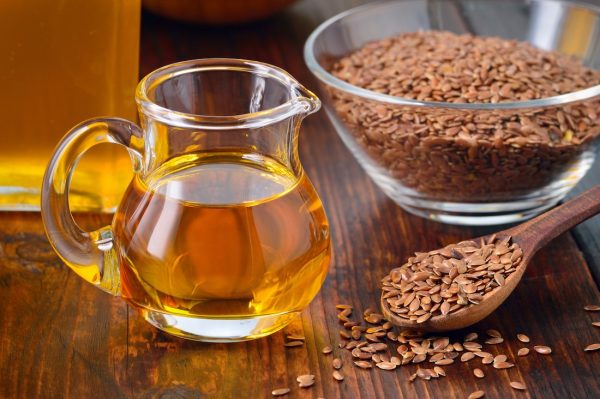
Only natural flax products can bring benefits to the body of the mother and the child - fresh seeds, natural cold-pressed oil. Taking capsules, dietary supplements and other preparations containing flax extract or oil during breastfeeding is undesirable due to the presence of excipients in the composition. With proper use of a natural product, it can bring tangible benefits to the body:
- normalizes the functioning of the gastrointestinal tract;
- helps cope with constipation;
- stabilizes female hormonal levels;
- helps in the fight against viral, fungal, bacterial diseases;
- prevents the development of breast cancer;
- improves the condition of skin and hair;
- promotes the functioning of the thyroid gland;
- increases immunity;
- prevents problems in the functioning of the kidneys, liver and heart.
It is difficult to overestimate the positive effect of omega fatty acids in flax on the development of the infant’s brain. The beneficial components contained in flax seeds and oil enter the child’s body along with the mother’s breast milk, contributing not only to the intellectual, but also to the physical development of the baby.
Flaxseed is often used to cleanse the body, especially during weight loss. Entering the stomach, it acts as an absorbent - it absorbs putrefactive food residues and removes them naturally.
Flaxseed is also taken as a lactation stimulant. It is known that plant analogues of female hormones can increase the volume of breast milk, but this effect is individual. Phytoestrogens also enhance the production of the hormones oxytocin and progesterone, which leads to rapid restoration of the menstrual cycle after childbirth and prepares the body for the next pregnancy.
Possible harm and contraindications
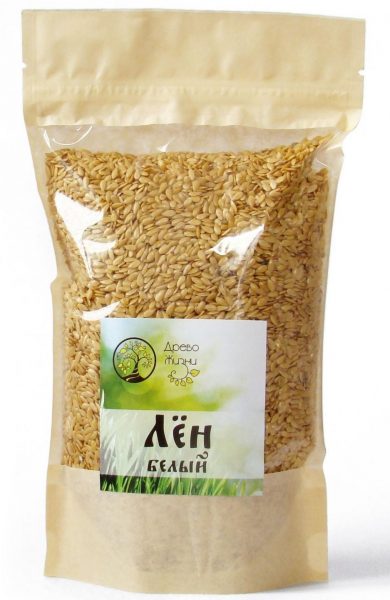
When deciding to include flaxseed, flour or oil in your diet, you should consult your doctor. This product is classified as a drug, so its uncontrolled use can be dangerous for mother and baby. The child may experience negative reactions: allergies or digestive disorders. Flax seed is classified as a low-allergenic product, but cases of individual intolerance, especially in early childhood, cannot be ruled out. In some cases, flax in the diet of a nursing mother causes increased colic in the newborn, increased gas formation, and even diarrhea in the baby. Do not forget about the laxative properties of flax, which also extend to the woman herself.
Contraindications to the use of flax are:
- high blood pressure;
- endometritis or uterine fibroids;
- pancreatitis;
- diseases of the gallbladder and biliary tract;
- kidney pathologies;
- stomach ulcer and inflammatory processes of the gastrointestinal tract.
An overdose of the product can lead to diarrhea and digestive disorders. Neglecting contraindications is fraught with aggravation of existing diseases and deterioration of well-being.
Contraindications and existing restrictions
If flax is consumed immediately after a cesarean section, it can cause bleeding in a woman. If the product is abused, mother and child may experience digestive disorders.
There are a number of diseases in which flax is contraindicated for a nursing mother, despite all its beneficial properties. In order not to provoke an exacerbation of the condition, flax products will have to be excluded from the diet if the woman has a history of the following diseases:
- endometritis;
- uterine fibroid;
- polycystic disease;
- diarrhea;
- hypertension;
- hypertension;
- housing and communal services diseases;
- cholelithiasis.
Prepared medicinal preparations cannot be stored for a long time. Therefore, it is better to cook them little by little and take them fresh. To get the maximum benefit from flaxseed products, a nursing mother should definitely consult a doctor and strictly follow all recommended dosages.
Flaxseed oil and HS: is there any danger?
Flax seeds and their derivatives contain special compounds - lignans. They have anti-inflammatory and antitumor effects, stimulate the nervous system, but also have estrogenic activity, i.e. are able to influence a woman’s hormonal levels, increasing the amount of estrogen in the body.
In cases where the expectant or nursing mother does not have hormonal problems, excess estrogen caused by taking flaxseed oil can provoke a number of problems, including:
- risk of premature birth;
- disorders of intrauterine development in the fetus;
- prolonged postpartum bleeding;
- high probability of tumors appearing in the breast;
- the formation of toxic substances as a result of the oxidation of excess linoleic acid;
- disruption of hormonal levels, which are naturally created during lactation and prevent the onset of a new pregnancy, which increases the likelihood of unplanned conception;
- a malfunction in the gastrointestinal tract of the infant associated with the penetration of difficult-to-digest product components into breast milk.
The insidiousness of flaxseed oil also lies in the fact that the amount of lignans per unit volume is not reduced to any standard value; it is simply impossible to calculate their quantity and the corresponding dose in advance . In addition, these compounds pass into breast milk quite quickly, but leave it about 6-7 days after the end of administration.
Flaxseed oil easily becomes unusable from heat and light, so to prevent oxidation, manufacturers often add various synthetic compounds to it, which does not add beneficial properties to breast milk.
Fully or partially limited products
The diet of a nursing mother according to Komarovsky excludes:
- Foods with a high potential for allergic effects (fish roe, whole milk, citrus fruits, mushrooms, eggs, fish, seafood (especially shrimp and crab), crayfish, honey, cocoa, coffee, chocolate, bright red and orange fruits.
- Products and dishes that enhance fermentation processes in the intestines (kvass, legumes, rye bread, coarse vegetables, white cabbage, whole milk, yeast dough products, cucumbers), as well as products containing a large amount of essential oils (onions, garlic, celery, radish, spinach, radish).
- Tropical fruits (except bananas), fermented foods (cheeses, pickled vegetables), marinades.
- Rich meat and fish broths, canned meat and fish, fatty meats, fish, waterfowl, smoked meats, sausages, spices, hot spices and seasonings.
- Fast food products, products containing GMOs, dyes, preservatives, flavor enhancers.
- Confectionery, sweets, sugar, salt.
- Cooking, pork and beef fat, mayonnaise, margarine.
- Alcoholic and carbonated drinks.
It is possible, but only with caution: safe dosages
Flaxseed oil is a healthy and necessary product, but it must be introduced into the diet in moderation. It is its constant intake in large doses that poses a health hazard. Half a teaspoon for two months will be enough to replenish the reserves of polyunsaturated fatty acids in an adult.
Pregnancy and breastfeeding are not a contraindication to the use of flaxseed oil, but given its ambiguous effect on the body, it is better to refrain from its systematic use.
To prevent a deficiency of omega-3 fatty acids, it is enough for expectant and nursing mothers to diversify their diet with fatty fish caught from their natural habitat, as well as nuts, seeds, avocados, beans and peas. A couple of times a week you can season vegetable salads with flaxseed oil - there will definitely be no harm from such an amount of product.
We recommend reading: What kind of jam can you use while breastfeeding?
Product Information
Butter is a product obtained by processing the cream of cow's milk. There are two main methods of its production - separation and churning of the feedstock. To obtain 1 kg of quality product, 25 liters of milk are required.
The delicacy is divided into several types based on different criteria:
- type of cream – sweet cream (from pasteurized fresh cream), sour cream (from pasteurized fermented cream);
- presence of salt – salted and unsalted;
- share of fat – traditional (82.5%), amateur (80%), peasant (72.5%), sandwich (61%), tea (50%).
In addition to cream and salt, carotene (food coloring), bacterial starter cultures, vitamins, preservatives, flavorings, stabilizers, and emulsifiers can be used in production. In addition, products with sugar, cocoa, vanillin and other additional components are produced.
Oil is not commonly consumed as food on its own. As a rule, it is used for frying, making sandwiches and baking, and is also added to ready-made side dishes - porridge, pasta, potatoes (more details in the article: can a mother eat pasta while breastfeeding?).
Rules for use during breastfeeding

It is not recommended for a nursing mother to exceed the daily intake of flax seeds in the amount of 30–40 years. The allowed daily amount of natural flaxseed oil is about 2 tablespoons. The consumption rate of flax seed decoction during breastfeeding is no more than ½ glass per day. Flaxseed oil and plant seeds can be taken separately or combined with other dishes.
When introducing the product into your diet, follow the following recommendations:
- You can start taking flax products no earlier than the child turns 3 months old;
- You can eat only natural oil and flax seeds (flour) of natural origin;
- cannot be consumed on an empty stomach;
- can be combined with other products (add butter to salad, sprinkle seeds on baked goods, add to desserts, cereals, etc.);
- Oil must not be heated or used for frying foods (hazardous substances are released);
- for the first time you can try ½ tsp. oil or 1 tsp. seeds;
- The child’s reaction to flax is monitored for 2 days;
- if a rash, redness of the skin or digestive disorders appears, the product should be excluded from the diet;
- in the absence of a negative reaction in the infant, the volume of product in the diet is increased gradually, bringing it to the daily norm;
- It is recommended to try the product in the first half of the day, during the break between feedings;
- It is not recommended to use the product daily, 2-3 times a week is enough;
- for better absorption of flax seed components, it is advisable to combine it with foods containing vitamins E and B6 (fish, beans, spinach, chicken and others);
- Do not use flaxseed flour for baking in its pure form, dilute it with wheat variety (the share of flaxseed flour should not exceed 20% of the total volume of the dough).
Introduction to the diet for breastfeeding
Flax seeds are introduced into food for a nursing mother after two months of feeding the baby in the absence of allergies and intolerances. Only natural products are used; dietary supplements, capsules and tablets based on seeds are prohibited.
Flax should not be consumed when breastfeeding on an empty stomach; it is added to main dishes: salads, vegetables, and baked goods. The seeds are eaten with beans, nuts, spinach, fish, chicken, wheat or oat porridge. These foods contain vitamins E and B6, which help in the absorption of nutrients.
In the first month
The product should not be consumed immediately after birth. Flax seeds for infants are an unknown ingredient in the menu; the baby’s digestive system cannot cope with its breakdown. As soon as the child’s stomach adapts to the new conditions, foods begin to be introduced.
Features of selection, storage, application
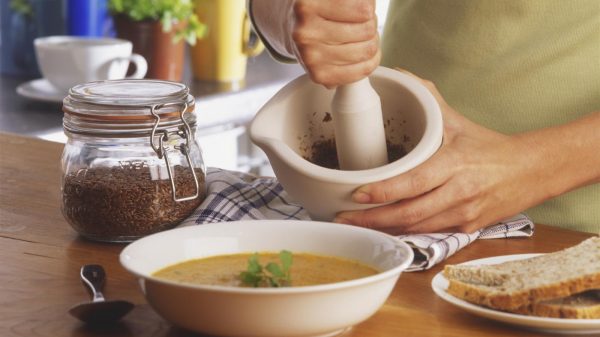
A nursing mother is allowed to consume the following flax products:
- natural oil;
- fresh dried whole grains;
- seeds ground into flour or crushed;
- decoction of seeds.
Flaxseed oil can be drunk fresh, separately from other types of food, but not on an empty stomach. The optimal use is as a dressing for salads and side dishes. When purchasing, give preference to oil in a dark glass container of small volume (250 ml). The product is classified as perishable, so it is stored in the refrigerator in a container with a tightly closed lid. Flaxseed oil is not suitable for frying; it should not be heated, as it releases toxins when heated.
It is advisable to purchase seeds in a pharmacy in small individual packaging. When consuming seeds, for better absorption they should be chewed thoroughly and washed down with water. Ground flax seeds and flour can be added to baked goods, sauces, snacks, cereals, dairy products, and smoothies. Ground and whole flax seed should be stored in a place protected from light and high temperatures with good ventilation and in glass containers.
Flax decoction is usually used to treat diseases of internal organs. The drink is also called jelly because of its specific consistency. It is advisable to consume it freshly brewed. The finished broth can be stored in the refrigerator for no more than 2 days. To prepare the decoction, flax seeds (1 tablespoon) are poured with boiling water (200 ml) in a thermos and infused for 2 hours.
Daily norm
2 months after giving birth, you can start taking flax seeds to a nursing mother. First, eat half a teaspoon and work up to one tablespoon per day.
The permissible amount of decoction is 1⁄2 cup daily. The indicated dosages do not exceed during the entire period of breastfeeding.
What to replace
If flaxseeds are not available, sesame seeds and walnuts are used instead.
Authorized Products
The diet of a nursing mother according to Komarovsky includes:
- Wheat bread with bran/cereal, dry biscuits, grain crispbread, non-sweet biscuit.
- Various cereals, cooked in water or with the addition of 1/3 milk, cereal products (casseroles with cottage cheese, puddings).
- Dietary varieties of meat (veal, rabbit, beef, chicken) and fish (cod, hake, pollock, pike perch, blue whiting, bream) in whole pieces or in the form of steam cutlets.
- Vegetable and cereal soups in secondary meat broth with the addition of pieces of boiled meat, meatballs, quenelles.
- Vegetables (at least 500 g/day) boiled or, if the child is well tolerated, fresh. It is recommended to use neutral vegetables: zucchini, squash, beets, carrots, pumpkin. It is better to eat green vegetables fresh, and heat-treat brightly colored ones (yellow and orange). But you need to introduce vegetables boiled or stewed.
- Fermented milk products (600-800 ml/day) - yogurt, kefir, acidophilus, natural yogurt, cottage cheese or dishes based on it. It is better to use sour cream and cream as an additive to ready-made dishes. The optimal fat content for fermented milk products is 2.5%, and for cottage cheese - 5-9%. Zero-fat products are not suitable for nursing mothers.
- Fruits/berries (up to 300 g/day). It is recommended to start eating fruits with green or white apples, then introduce other types (pears, gooseberries, currants, cherries), you are allowed to use baby juices, fruit purees, juices (preferably with pulp), baked apples and pears (200-300 ml) . Dried fruits are allowed to be consumed, but they must be introduced into the diet carefully, observing the child’s stool.
- From fats, you can consume butter (25/day) and cold-pressed vegetable oils (15 g/day) (olive, corn, sunflower, flaxseed), adding them to porridges, salads, and baked/boiled vegetables.
- Among confectionery products, you can occasionally include marshmallows, meringues, marshmallows, and fruit marmalade.
- Drinks - green tea without aromatic additives, still table water, compotes and fruit drinks, rosehip decoction, teas with mint, thyme, oregano.
| Proteins, g | Fats, g | Carbohydrates, g | Calories, kcal | |
| zucchini | 0,6 | 0,3 | 4,6 | 24 |
| cauliflower | 2,5 | 0,3 | 5,4 | 30 |
| potato | 2,0 | 0,4 | 18,1 | 80 |
| carrot | 1,3 | 0,1 | 6,9 | 32 |
| pumpkin | 1,3 | 0,3 | 7,7 | 28 |
| bananas | 1,5 | 0,2 | 21,8 | 95 |
| cherry | 0,8 | 0,5 | 11,3 | 52 |
| pears | 0,4 | 0,3 | 10,9 | 42 |
| plums | 0,8 | 0,3 | 9,6 | 42 |
| apples | 0,4 | 0,4 | 9,8 | 47 |
| baked sweet apples | 0,5 | 0,3 | 24,0 | 89 |
| gooseberry | 0,7 | 0,2 | 12,0 | 43 |
| dried fruits | 2,3 | 0,6 | 68,2 | 286 |
| buckwheat (kernel) | 12,6 | 3,3 | 62,1 | 313 |
| oat groats | 12,3 | 6,1 | 59,5 | 342 |
| cereals | 11,9 | 7,2 | 69,3 | 366 |
| pearl barley | 9,3 | 1,1 | 73,7 | 320 |
| Wheat groats | 11,5 | 1,3 | 62,0 | 316 |
| millet cereal | 11,5 | 3,3 | 69,3 | 348 |
| white rice | 6,7 | 0,7 | 78,9 | 344 |
| barley grits | 10,4 | 1,3 | 66,3 | 324 |
| white bread crackers | 11,2 | 1,4 | 72,2 | 331 |
| vysivkovy bread | 9,0 | 2,2 | 36,0 | 217 |
| jam | 0,3 | 0,2 | 63,0 | 263 |
| marshmallows | 0,8 | 0,0 | 78,5 | 304 |
| fruit and berry marmalade | 0,4 | 0,0 | 76,6 | 293 |
| meringues | 2,6 | 20,8 | 60,5 | 440 |
| paste | 0,5 | 0,0 | 80,8 | 310 |
| Maria cookies | 8,7 | 8,8 | 70,9 | 400 |
| milk 2.5% | 2,8 | 2,5 | 4,7 | 52 |
| kefir 2.5% | 2,8 | 2,5 | 3,9 | 50 |
| sour cream 15% (low fat) | 2,6 | 15,0 | 3,0 | 158 |
| Ryazhenka 2.5% | 2,9 | 2,5 | 4,2 | 54 |
| acidophilus | 2,8 | 3,2 | 3,8 | 57 |
| natural yogurt 2% | 4,3 | 2,0 | 6,2 | 60 |
| cheese | 24,1 | 29,5 | 0,3 | 363 |
| cottage cheese 5% | 17,2 | 5,0 | 1,8 | 121 |
| cottage cheese 9% (bold) | 16,7 | 9,0 | 2,0 | 159 |
| lean pork | 16,4 | 27,8 | 0,0 | 316 |
| boiled beef | 25,8 | 16,8 | 0,0 | 254 |
| boiled veal | 30,7 | 0,9 | 0,0 | 131 |
| rabbit | 21,0 | 8,0 | 0,0 | 156 |
| boiled chicken | 25,2 | 7,4 | 0,0 | 170 |
| turkey | 19,2 | 0,7 | 0,0 | 84 |
| butter | 0,5 | 82,5 | 0,8 | 748 |
| mineral water | 0,0 | 0,0 | 0,0 | — |
| green tea | 0,0 | 0,0 | 0,0 | — |
| black tea | 20,0 | 5,1 | 6,9 | 152 |
| Apple juice | 0,4 | 0,4 | 9,8 | 42 |
| * data is per 100 g of product | ||||
Is it possible to eat or drink flax seeds while breastfeeding and in what form?
Doctors and lactation consultants do not have a consensus on the possibility of using flaxseeds for breastfeeding. Some believe that the harmful properties of the product are too great and such use is unsafe. The majority is inclined to think that the benefits significantly outweigh the harm, and side effects are quite rare, so the product can be eaten. It is better to consult with a specialist regarding the possibility of using flax in your case.
In the first month
It is recommended to introduce the product into the diet for the first time 3 months after birth, but it is also allowed when the baby is one month old. The child’s body will become strong enough to accept new products on the mother’s menu.
Oil
Flax seed oil is similar in composition to flax seeds. This is a concentrate of the useful substances of the product. Flaxseed oil is allowed for breastfeeding. It is much more effective than seeds in treating constipation. It is recommended to start using ½-¼ teaspoon per day. If there is no reaction, the dosage can be increased. The maximum dose is 2 tablespoons per day. Due to the unstable concentration of ligans in the oil, it is impossible to determine the exact dosage, and excessive use can lead to adverse reactions, so be sure to consult a doctor before taking it.
We recommend reading: Liver during breastfeeding
Flaxseed flour
Flaxseed flour has recently been increasingly used in cooking. If you want to use it in baking, remember: flaxseed flour is used as an additive to wheat, oatmeal and other types of products. Its composition is too active for independent use, especially for nursing women.
You can buy it in a store or pharmacy, but the healthiest one is the one you prepare yourself. To do this, take flax seeds and mash them in a mortar. You can use a blender or coffee grinder, but the product reacts with the metal, which can give the flour a distinct flavor. It is best to use this flour immediately after production.
Flaxseed flour with kefir
Flaxseed flour is most often used by women for weight loss. A 3-week course to lose excess weight is recommended. It should be noted that for maximum effect you need to give up unhealthy foods, fried foods, flour products and drink a lot of clean water. The diet is based only on flour and kefir, so it is perfect for women who have gained extra pounds during pregnancy.
So, for 3 weeks you need to drink the following drink.
Compound:
- Flaxseed flour.
- Kefir.
Preparation:
Mix kefir with flour.
Proportions:
1 week - 1 teaspoon of flour per 100 ml of kefir.
Week 2 - 1 tablespoon of flour per 100 ml of kefir.
Week 3 - 3 tablespoons of flour per 200 ml of kefir.
Application : Drink the mixture cold in the morning on an empty stomach every day. You can't heat flax.
Urbech
It is recommended to use flaxseed urbech for breastfeeding from the age of 3 months. This product is rich in vitamins and minerals. If there is no allergy, it will help cope with many breastfeeding problems, including hypolactation. Flaxseed paste is believed to help increase the quantity and nutritional value of breast milk.
It is possible to prepare flax urbech at home yourself; read more about this in the article “How to prepare urbech from flax seeds at home?”
Decoction
It is recommended to drink a decoction of flax seeds for diseases of internal organs, especially the gastrointestinal tract. The second name of the drink is flaxseed jelly.
Compound:
- Flax seeds - 2 tsp.
- Boiling water - 1 glass.
Preparation:
- Pour boiling water over the seeds in a thermos.
- Let stand for 2 hours.
- Strain.
Application : Drink the liquid freshly prepared. Do not store the decoction for more than 2 days. During breastfeeding, it is forbidden to drink more than half a glass a day.
Porridge
Flaxseed porridge during breastfeeding is very beneficial for the body. Remember that multi-component dishes can be eaten by nursing women only after introducing the components separately into the diet.
For more information about the benefits of flax porridge for mothers and babies, read the article “Flax porridge during breastfeeding.”
You can prepare flaxseed porridge at home using the following recipes:
- Flax porridge with banana for nursing mothers.
- Flaxseed porridge with dates for breastfeeding mothers.
Correct preparation and use
A properly prepared product will help the body improve its health and will not give side effects. Therefore, it is important to follow all recommendations of specialists regarding the use of drugs.
Decoction
To prepare the decoction you will need 2 tablespoons of seeds. They are poured with a liter of water and the mixture is kept in a water bath for two hours. The prepared decoction should be stored in the refrigerator and drunk half a glass a day.
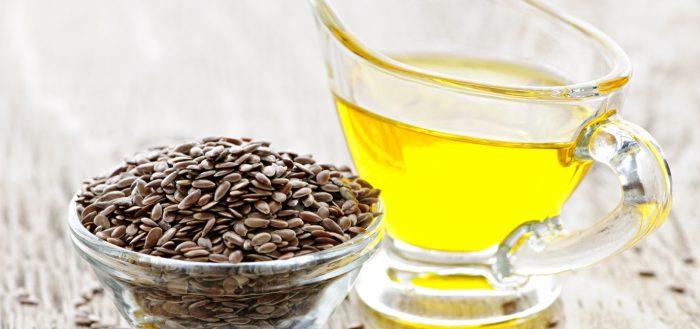
Flaxseed infusion
Pour boiling water over 1 tablespoon of grains, cover tightly with a lid and leave for 15 minutes. The resulting infusion is filtered and drunk.
Kissel
If you add a spoonful of flaxseed to a hot fruit compote, you will get a healthy and tasty jelly. In this case, it is not sugar that is added to the compote, but honey (it can also be added to the cooled compote).
Flaxseed porridge
Flaxseed porridge is useful not only for nursing mothers, but also for pregnant women. The rich chemical composition provides the child with the substances necessary for normal development, which he receives along with mother's milk.
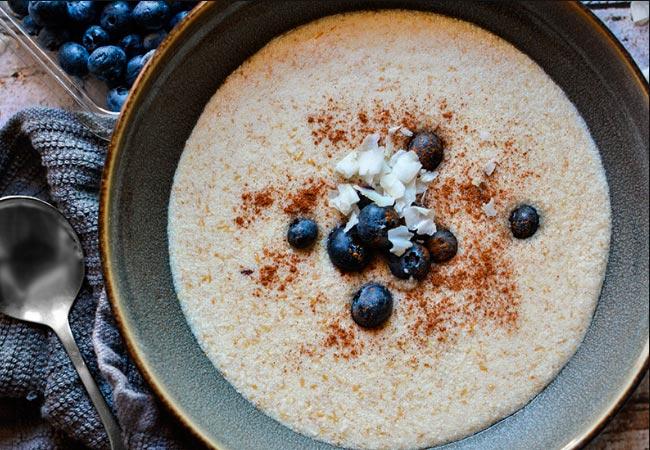
You can buy porridge in a store, but a self-prepared product will be much healthier. The seed must be ground into flour and mixed with any cereal (buckwheat, oatmeal). You can add dried fruits, nuts or honey to the resulting mixture, but only if mother and child are not allergic to these products. All this is poured with boiling water or hot milk; there is no need to cook such porridge.
Allergy
Despite the benefits, the question “Is flaxseed oil ok when feeding a baby?” remains controversial. One of the contraindications is a possible allergy in the baby. Start any new food with small portions and observe the baby’s reaction. Signs of allergies:
- Skin damage. A rash, dryness, and peeling appear on the delicate skin. In a newborn, a rash appears in the groin, knee bends, face and neck. Skin lesions may be mild or spread throughout the body.
- Tummy problems. After introducing a new diet, constipation, diarrhea, rumbling in the stomach, and colic appear. This type is called intestinal allergy.
- Cry. The baby cannot complain of itching or discomfort in the intestines, so he sleeps poorly, cries, twists his legs, and bends over.
Important points
Taking flax while breastfeeding is prohibited in the following cases:
- In case of delivery by caesarean section.
- In the first weeks of a child's life.
- You should not give your baby oil or flax seed - they are difficult to digest and can cause problems with the esophagus.
- Strong changes in hormonal levels.
- An overdose can cause nausea in the mother, worsening of chronic diseases, and developmental retardation in the child.
- Presence of female diseases (uterine fibroid, endometritis, polycystic disease, etc.).
- High blood pressure.
- Chronic stage of pancreatitis.
The quality of linseed oil depends on many factors: shelf life, bottle transparency (must be light-protective), bottling and transportation conditions (unfortunately, cannot be tracked).
Read more about the use of flax for children in a separate article.
Buying flaxseed oil: what to look for?
Pay attention to the following signs indicating a high quality product:
- the oil is bottled in dark glass;
- when buying oil, you get it from the refrigerator, and not from a display case or shelf;
- the label indicates all the necessary dates: production, bottling, consumption, etc., as well as information that storage is necessary in a dark and cool place;
- There are no artificial additives in the composition.
If the oil you purchased meets the above characteristics, then this is a high quality product.
Polyunsaturated fatty acids must be included in the diet of a nursing mother. Not many products can boast of containing them, and flaxseed oil is one of the available ways to compensate for the lack of omega-3. But do not forget that excessive consumption of this product, especially by expectant and nursing mothers, is unacceptable.
How to choose a quality product
In order not to harm the body, you should follow certain rules when choosing and storing products:
- Oil should be purchased in a small dark glass container. It spoils quickly, so store it in the refrigerator, tightly closing the container.
- It is recommended to buy seeds at a pharmacy; they should be in small packages. When purchasing, you should pay attention to the friability of the product and the presence of a glossy sheen. The surface of the grains should be dry and free of mold.
- Whole grains and flour obtained from them are stored in a cool, dark place with good ventilation. Glass containers are used for storage.

